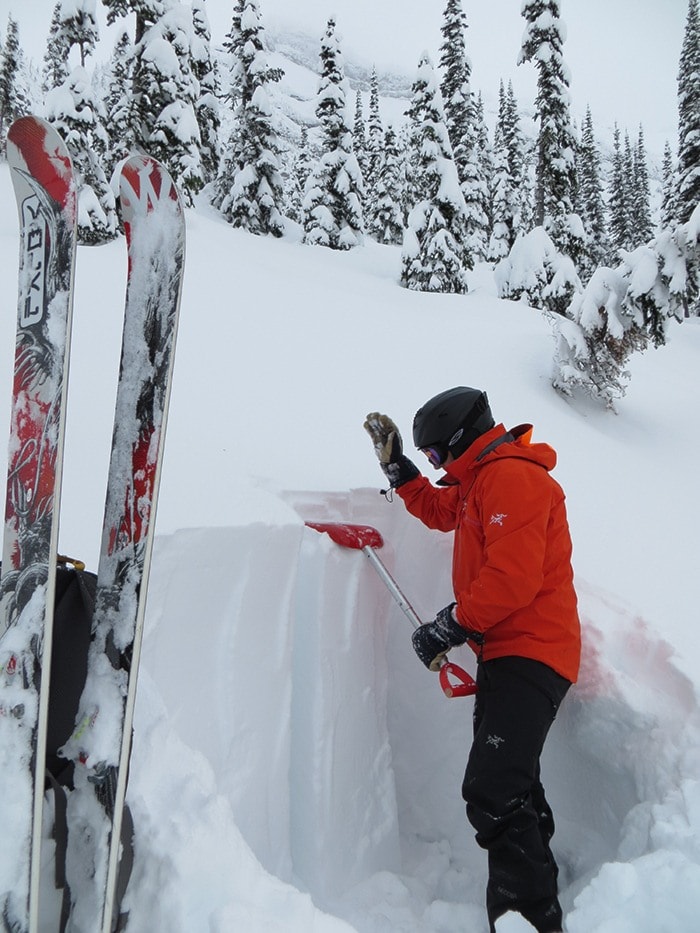A ski town like Fernie has its share of people seeking untouched powder to ski, board or snowmobile fresh lines. Avalanche awareness can help enthusiasts mitigate risk to themselves and other parties sharing the backcountry.
Eric Ridington has been an Association of Canadian Mountain Guides (ACMG) ski guide for 12 years and is now living in Fernie.
“This is one of those years that has persistent weak layers in the snow pack and a higher degree of caution is needed, particularly with less experienced mountain travellers. Choice of terrain is the most important consideration.”
Consider the possibility that a small avalanche may step down to weak basal layers and produce a large destructive avalanche.
“Often people are really lucky,” said Ridington. “They don't even realize how dangerous a situation they were in. Because nothing [bad] happened, they assume they made the right decision but they don't know that they came close to triggering an avalanche.”
What about digging snow pits? Technically, they are known as a full snow profile or a test profile.
“Test profiles are to track layers in the snow to see how reactive they are and how they change over time,” said Ridington. Not to make go-no-go decisions about a specific slope. Safe backcountry travel depends more on choosing safe terrain than looking at layers in the snow.”
An example of the observation Ridington noted on January 10 in the Fish Bowl east of the Fernie Alpine Resort ski boundary was 255 centimetres of total snow, with 80 cm over the December facet crust surface hoar layer combo. There were easy to moderate sheers in the top 30 cm of recent storm snow. There was a moderate sheer down 77 cm in the old snow where it interfaced with surface hoar. At present there was very little wind effect at the tree line and below the tree line. However, the alpine locations have experienced strong southwest winds and numerous size two natural avalanches were observed.
“Stick to the ribs and ridges and areas with safe run outs; avoiding steep rolls and steep, large slopes,” said Ridington.
This is an example of an observation an ACMG like Ridington can post on the Mountain Conditions Report which is accessible to the general public. ACMG also use the Informalex, which is information shared online with ACMG only. Then there is the Infoex, which is information shared between ski areas, heli skiing and cat skiing operations and highways avalanche control.
When the Canadian Avalanche Centre issues their reports for the public, they are drawing from the MCR, Informalex, Infoex, plus their own information gathering.
“You could have good quality skiing, but in certain conditions you need to choose conservative terrain,” said Ridington. “This is a year to be aware of the persistent weak layers (PWL). The professional guiding industry has learned to deal with these kinds of PWL winters but the general public do not always adjust their decision making and choice of terrain use. It's early in the winter yet.”
The Canadian Avalanche Centre send a consistent message for people to get avalanche training and have avalanche rescue gear before travelling in the backcountry, but still many backcountry travellers do not have both.
“I highly recommend Avalanche Skills Training Level 1 and 2, and professional courses for those working in the industry. People travelling in the backcountry really should have the basic AST Level 1.”
“People who go in the backcountry without avalanche rescue gear are ignorant to the risks they are exposing themselves to,” said Ridington.
The equipment is for rescue, not prevention. Safe backcountry travel requires the experience to identify and recognize safe terrain.
A list of equipment Ridington carries in the backcountry:
Airbag system backpack (ABS)
three way antennae transceiver/beacon
probe
shovel
snow/bush saw
emergency tarp/shelter that can be used as a rescue toboggan
pot and fire lighting equipment
first aid kit
compass and maps
whistle
GPS
satellite phone and or cell phone
SPOT emergency devise
Leatherman or multi-tool
extra clothing
food and water
helmet
For up to date avalanche conditions and forecasting visit www.avalanche.ca/cac/ or www.acmg.ca.
